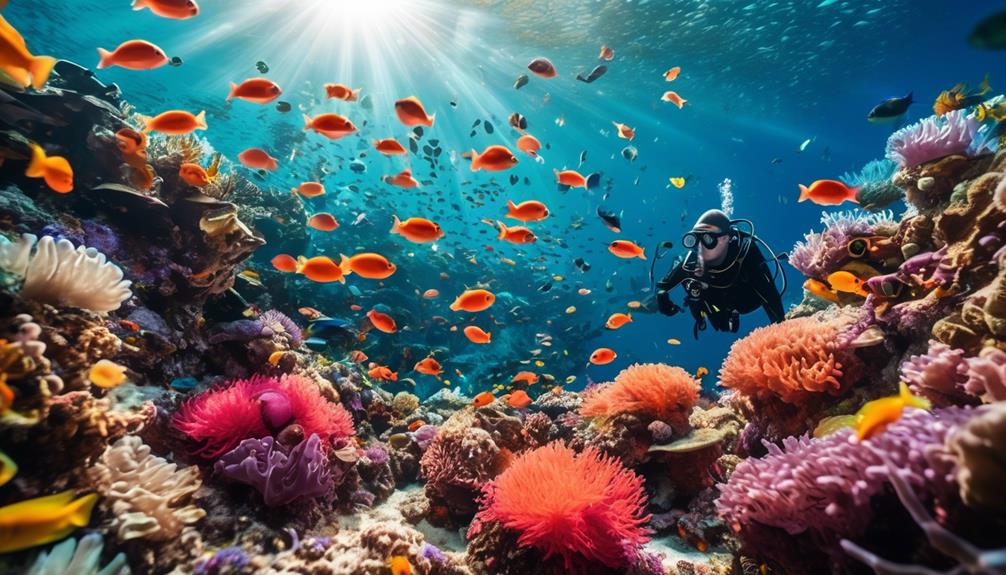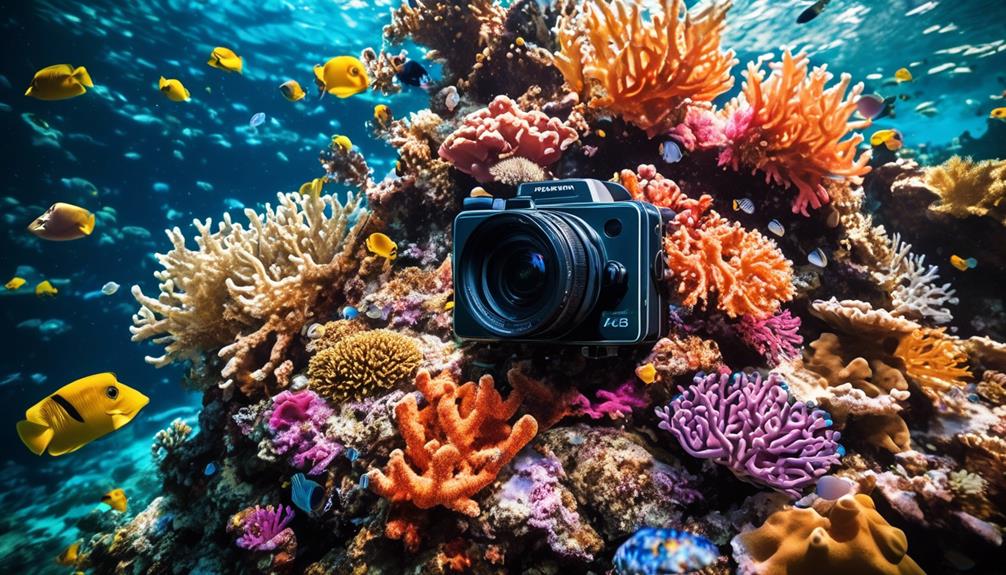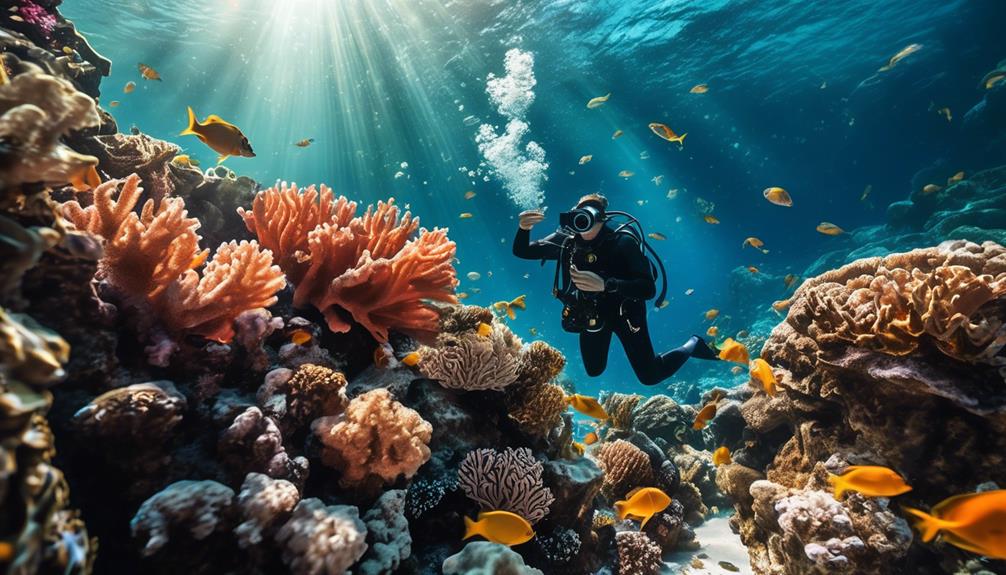Please note this post may contain affiliate links picked by me (Jay) that I have deemed may be of interest or relevant to you the reader of this.
These links do not affect the cost of the thing if you decide to purchase but i may get a little money if you choose to purchase.
For more information on my affiliate link policy click here.
Diving into the world of underwater marine photography is like embarking on a breathtaking journey through an ethereal realm. As I dipped my toes into the crystal clear waters, I was awestruck by the vibrant colors and mesmerizing creatures that awaited me beneath the surface.
Capturing these moments was a challenge I eagerly embraced, my camera becoming a portal to a hidden world that few have the privilege to witness. But where does one begin in this underwater wonderland? How does one navigate the depths and capture the beauty that lies beneath?
Join me as I unveil the first steps to embark upon this mesmerizing adventure, where the secrets of underwater marine photography are waiting to be unlocked.
Key Takeaways
- Choosing the right underwater camera and accessories is important for successful underwater photography.
- Regular maintenance, such as rinsing the camera with fresh water and wiping away saltwater and dirt, is necessary to keep the camera in good condition.
- Underwater housings provide protection and control, while strobes and underwater lights enhance colors in photos.
- Having different lenses and understanding lighting and composition techniques can add versatility and creativity to your underwater photography.
Choosing the Right Underwater Camera
When it comes to capturing stunning underwater images, choosing the right underwater camera is essential for ensuring that your photos turn out crisp, vibrant, and truly breathtaking. As an avid underwater photographer, I understand the importance of having the right equipment to capture the beauty of the marine world. Not only do you need a camera that's capable of capturing high-quality images, but you also need to consider underwater camera maintenance and the availability of underwater camera accessories.
When it comes to maintenance, it's crucial to keep your underwater camera clean and free from any debris or residue that could affect image quality. Regularly rinsing your camera with fresh water after each dive and using a soft cloth to wipe away any saltwater or dirt can help prolong its lifespan and ensure optimal performance.
In addition to maintenance, having the right accessories can enhance your underwater photography experience. Accessories such as underwater housings, strobes, and lenses can help you capture more professional-looking images. Underwater housings provide protection for your camera and allow you to control its functions while diving. Strobes and underwater lights are essential for illuminating subjects in the dark underwater environment, bringing out vibrant colors and details. Different lenses, such as wide-angle or macro lenses, offer versatility in capturing different types of marine life.
Essential Equipment for Underwater Photography
As an underwater photographer, I know that having the right equipment is key to capturing breathtaking images of the marine world. Here are four essential pieces of equipment that every underwater photographer should have:
- Underwater Camera: Investing in a high-quality underwater camera is crucial. Look for a camera that's specifically designed for underwater use, with features such as waterproof housing, image stabilization, and high resolution. This will ensure that you can capture stunning images even in challenging underwater conditions.
- Wide-angle Lens: A wide-angle lens is essential for capturing the vastness and beauty of the underwater world. It allows you to capture more of the scene and adds depth to your images. Experiment with different focal lengths to find the perfect lens for your underwater photography.
- Strobe or Flash: Proper lighting is crucial for underwater photography, as water absorbs light and can dull your images. A strobe or flash will help you illuminate your subject and bring out its true colors. Experiment with different lighting angles and intensities to create stunning underwater images.
- Editing Software: Once you've captured your underwater images, post-processing is essential to enhance their beauty. Use editing software to adjust colors, contrast, and sharpness, and to remove any unwanted elements. Familiarize yourself with different post-processing techniques to bring out the best in your underwater photographs.
Understanding Lighting and Composition Underwater
To capture stunning underwater photographs, mastering lighting and composition is essential. Underwater photography presents unique challenges, but with the right techniques and equipment, you can create breathtaking images that showcase the beauty of the underwater world.
When it comes to lighting, understanding how it behaves underwater is crucial. Water absorbs and scatters light, resulting in reduced color and contrast. To overcome this, it's important to use artificial lighting such as strobes or video lights. Positioning the lights at different angles can create depth and add dimension to your images. Experimenting with different lighting setups will help you achieve the desired effect.
Composition is equally important in underwater photography. It involves arranging the elements in your frame in a visually pleasing way. To create an engaging composition, consider the rule of thirds, leading lines, and negative space. These techniques can help you create a balanced and visually appealing image.
To further enhance your underwater photographs, understanding your underwater camera settings and utilizing post-processing techniques is essential. Adjusting settings such as white balance, exposure compensation, and shutter speed can greatly impact the overall look of your images. Additionally, post-processing techniques such as color correction and sharpening can help bring out the details in your underwater photographs.
Incorporating these lighting and composition techniques, along with mastering your camera settings and post-processing techniques, will enable you to capture stunning underwater photographs that truly stand out. So dive in, explore the underwater world, and unleash your creativity!
Mastering Basic Underwater Photography Techniques
Let's dive into the world of underwater photography and uncover the basic techniques that will take your images to the next level.
Underwater photography is a mesmerizing and innovative field that allows you to capture the beauty of the underwater world. To capture vibrant colors and stunning images, it's crucial to master the following techniques:
- Understand your underwater photography settings: Familiarize yourself with the manual settings of your camera, such as aperture, shutter speed, and ISO. Adjusting these settings will help you achieve the desired exposure and clarity in your photos.
- Use natural lighting to your advantage: Natural light is your best friend underwater. Position yourself in a way that allows the light to illuminate your subject. Pay attention to the direction, intensity, and color temperature of the light to create dynamic and captivating images.
- Get close to your subject: Water tends to reduce clarity and color in your photos. To combat this, get as close as possible to your subject. This won't only enhance the details but also intensify the vibrant colors.
- Experiment with white balance: Underwater environments can have a color cast due to the water's inherent blue or green hue. Adjusting the white balance settings on your camera can help neutralize these colors, resulting in more accurate and vivid images.
Tips for Exploring Marine Life Through Your Lens
Diving beneath the surface, I'm captivated by the diverse and enchanting marine life that awaits to be discovered through the lens of my camera. As an underwater photographer, it's essential to have the right gear to capture the vibrant colors and unique beauty that lies beneath the waves. Investing in high-quality underwater photography gear is crucial for achieving stunning images.
One essential item is an underwater housing for your camera. This protective case allows you to take your camera underwater without worrying about damage. Make sure to choose a housing that's compatible with your camera model for a secure fit. Additionally, a strobe or underwater flash is essential for illuminating subjects in the dark underwater environment. This will help bring out the vibrant colors and details in your photos.
When exploring marine life through your lens, it's important to be patient and observant. Look for intriguing subjects such as colorful coral reefs, exotic fish, and fascinating sea creatures. Take your time to compose your shots, focusing on interesting patterns, textures, and interactions between different species.
To capture vibrant colors underwater, it's crucial to understand how light behaves in water. As you descend deeper, the water absorbs different colors, resulting in a bluish tint. To counteract this, use a color correction filter or adjust the white balance settings on your camera. This will help restore the natural colors and create more visually appealing images.
Exploring marine life through underwater photography is an exhilarating experience. With the right gear and techniques, you can capture the beauty and diversity of the underwater world like never before. So grab your camera, dive in, and let your lens reveal the hidden wonders that await beneath the waves.
Frequently Asked Questions
What Are Some Common Challenges Faced by Underwater Photographers and How Can They Be Overcome?
Overcoming challenges in underwater photography is essential for capturing stunning images of marine life in low light conditions. It can be difficult to maintain stability underwater, but using a tripod or stabilizing device can help.
Another challenge is dealing with limited visibility, which can be improved by using artificial lighting or adjusting the camera's settings.
Additionally, mastering the art of underwater composition and focusing techniques is crucial.
With practice and the right techniques, underwater photography can become an exciting and rewarding endeavor.
Are There Any Specific Camera Settings or Shooting Modes That Are Recommended for Underwater Photography?
When it comes to underwater photography, there are definitely some recommended camera settings and shooting modes that can make a big difference.
First, I'd suggest using a fast shutter speed to freeze the motion of the water and the marine life.
Additionally, adjusting the white balance to the appropriate setting can help capture vibrant colors underwater.
Lastly, experimenting with different shooting modes, like macro or wide-angle, can help you capture the unique beauty of the underwater world.
How Important Is Post-Processing in Underwater Photography and What Software Is Recommended?
Post-processing plays a crucial role in underwater photography, like adding the final touches to a masterpiece. It helps enhance colors, balance exposure, and bring out the stunning details submerged beneath the surface.
For beginners, software like Adobe Lightroom and Photoshop are highly recommended. They offer powerful tools to correct white balance, reduce noise, and fine-tune images.
With underwater photography's challenges, such as limited visibility and color loss, post-processing becomes the key to overcome them and create captivating underwater images.
What Are Some Safety Precautions That Underwater Photographers Should Take While Diving?
When it comes to underwater photography, safety should always be a top priority. As an underwater photographer, I take several precautions while diving to ensure a safe and enjoyable experience.
First and foremost, I always check my underwater photography equipment before each dive to make sure everything is in working order.
Additionally, I choose the best locations for underwater photography that have clear visibility and minimal currents.
Lastly, I never dive alone and always have a dive buddy with me for added safety.
Are There Any Specific Techniques for Photographing Different Types of Marine Life, Such as Sharks or Coral Reefs?
When it comes to underwater photography, there are specific techniques for capturing different types of marine life. Whether you're photographing sharks or coral reefs, it's important to have the right equipment for the job.
Underwater photography tips include adjusting your camera settings for the best results, using natural lighting to enhance the colors, and getting up close to your subject for a more immersive shot.
With the right techniques and equipment, you can capture stunning images of the underwater world.
Conclusion
In conclusion, diving into the world of underwater marine photography is an enchanting adventure that allows us to capture the mesmerizing beauty of the ocean. Armed with the right equipment, knowledge of lighting and composition, and mastery of basic techniques, we can explore the depths and immortalize the wonders that lie beneath.
So, let's dive in and embark on this incredible journey, where every click of the camera unveils a hidden world of awe-inspiring marine life.


